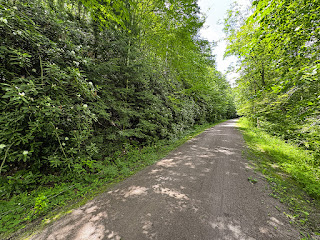Great Allegheny Passage Bike Trail
Wednesday, December 3, 2025
Wanders on the Great Allegheny Passage | Flora | Bloodroot
Sunday, November 23, 2025
Wanders on the Great Allegheny Passage | Flora | Artemisia
The species that occurs in profusion along the GAP is probably Artemisia verlotiorum. A native of Eurasia, it was named after the brothers Jean Baptiste and Pierre Verlot, who in 1877 identified it as a different species from Artemisia vulgaris, although it has much the same medicinal and magical properties. The name of the genus is derived from Artemis, the Greek Goddess of the Moon. Paradoxically, Artemis is associated with both wild animals and the hunt (she and her twin brother are in Greek mythology credited with inventing the bow and arrow) and with childbirth and the care of children. She is often regarded as a protector of women in general. Her Roman form, Diana, is both the Goddess of the Hunt and the Protectress of Virginity.
The medicinal and magical lore involving the various species of artemisia around the world, including Artemisia verlotiorum, is vast. Known as the “Mother of Herbs”, artemisia is traditionally associated with women, and infusions, decoctions, and tinctures of artemisia leaves have been used to ease menstrual pain, aid childbirth, and support menopause. Both men and women have used artemisia to treat high blood pressure, improve circulation, and as a bitter tonic to stimulate digestion. Apart from its medicinal qualities, a simple infusion of Artemisia sweetened with maple syrup is a flavorful substitute for tea when used in moderation.
The crushed leaves of artemisia have a very distinctive smell. Burned as incense, the dried leaves are famous in many cultures worldwide for dispelling negative energy and warding off malignant spirits and other malevolent entities, including hostile human beings. (Raccoons, it should be noted, are not repulsed by artemisia; despite their bandit-like masks and propensity for mischief and thievery they are essentially benign creatures.) Sachets of artemisia can also be worn around the neck or elsewhere on the body to repulse negative influences. Fresh leaves placed under a pillow while one is sleeping are said to prevent nightmares and encourage lucid dreaming. If GAPers do nothing else, they should crush a handful of leaves and breathe in its intriguing aroma.
 |
| Young artemisia growing among the previous year’s stalks. 05.05.25 |
 |
| Artemisia grows in profusion along the GAP. 06.25.25 |
 |
| Flowering artemisia. 09.16.25 |
 |
| Flowering artemisia. 10.09.25 |
 |
| Flowering artemisia. 10.12.25 |
 |
| Dried leaves of artemisia make excellent incense. |
Friday, October 17, 2025
Wanders on the Great Allegheny Passage | Goldenrods
 |
| Early Goldenrod |
 |
| Early Goldenrod |
Towards the end of July and into the middle of August the flat-topped goldenrod (Euthamia graminifolia) makes its appearance. Although called a goldenrod, it belongs to the genus Euthamia, unlike other goldenrods. Three to four feet tall, its flowers consist of florets arrayed in a flat circle, rather than in a plume like most other goldenrods.
Throughout August the wrinkled-leaf goldenrod flowers. Although its showy plumes are not unlike early goldenrod, its leaves have a distinctive wrinkled look, and the leaves and stems tend to be a darker green than other goldenrods.
 |
| Wrinkled-leaf Goldenrod |
 |
| Wrinkled-leaf Goldenrod |
The signature plant of Autumn, the aptly-named tall goldenrod (Solidago altissima), flowers from the beginning of September to well into October. It can get up to six or seven feet tall and is extravagantly adorned with flamboyant plumes of yellow flowers. It grows in profusion along the GAP and often entirely covers adjacent meadows. This is one plant you cannot miss if you travel on the GAP after the first of September.
 |
| Tall Goldenrod |
Friday, October 3, 2025
USA | Pennsylvania | Mt. Davis
 |
| Summit Country Market (click on photos for enlargements) |
 |
| Halloween decorations on Summit Mills |
Beyond Summit Mills is the heart of Amish Country, with numerous well-appointed farms.
 | |
|
After about ten miles the road begins its ascent to the Mt. Davis ridgeline. The climb is easy for electric bikes but may be a bit daunting for regular bikes. Just short of the summit is a nice little park with picnics tables. Just past the park is the summit ridgeline.
Just past the summit sign a narrow road turning off to the left leads .9 of a miles to the parking lot near the Summit Observation Tower.
 |
| Sign marking the turnoff to the Observation Tower |
From the parking lot it’s 228 steps to the Observation Tower.
 |
| Beginning of the trail to the Observation Tower |
 |
| Observation Tower |
Friday, August 22, 2025
Great Allegheny Passage | New Book
In Cumberland, Maryland, the Spring, or Vernal, Equinox occurred at 11:06 p.m. on March 19, according to the Gregorian calendar imposed on the world by Pope Gregory XIII in 1582. The Equinox marks the astrological astronomical beginning of the spring season in the Northern Hemisphere. It’s often said that the Spring Equinox is when day and night are of equal length. Actually, due to an astronomical quirk, the date when day and night are equal, known as the Equilux, is usually a few days before the Equinox. This year March 15 has eleven hours, fifty-nine minutes, and fifty-five seconds of daylight. The next day has twelve hours, two minutes, and thirty-one seconds of daylight, so the pendulum has already swung toward longer days. The day of the Equinox has twelve hours, ten minutes, and twenty-four seconds of daylight. The next day has twelve hours, thirteen minutes, and zero seconds, making it two minutes and thirty-six seconds longer than the day before. The procession is on to the Summer Solstice, the longest day of the year, on June 20. I have decided that between the Spring Equinox and the Summer Solstice I will wander on the Great Allegheny Passage, a bike and hiking trail built on the roadbeds of now-abandoned railroads that extends 150 miles from Cumberland to Pittsburgh, Pennsylvania. Another trail, the C&O Canal Towpath, runs 184.5 from Cumberland to Washington, D.C, making it possible, in season, to ride a bike—or hike, if you are so inclined—334.5 miles from Pittsburgh to Washington. No motorized vehicles (except for electric bikes) are allowed on the entire path. Before proceeding on the GAP I will first explore the city of Cumberland . . . Continued.
Monday, July 7, 2025
Wanders on the Great Allegheny Bike Trail | New Book
 |
Wanders on the Great Allegheny Passage Bike Trail | Raccoons | New Flora
Starts Jul 6, 2025 05:30 PM
Ends Jul 7, 2025 06:32 PM
Saturday, July 5, 2025
Wanders on the Great Allegheny Passage Bike Trail | Deer | Flora
Starts Jul 4, 2025 03:26 PM
Ends Jul 5, 2025 04:27 PM
 |
| Keep seeing this two fawns at the same place. I assume they are twins (click on photos for enlargement), |
Witches Broom flourishing!!!






































.JPG)